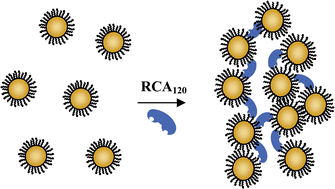Ricin is a toxic lectin which presents a potential security threat. Its rapid detection is highly desirable. Here we present a colorimetric bioassay based on the aggregation of carbohydrate-stabilised gold nanoparticles which has been used to detect Ricinus communis Agglutinin 120 (RCA120) – a ricin surrogate. To achieve a stable and robust sensing system the anchor chain length and the density of the assembled carbohydrates on the gold particle surface has been examined to determine the optimal coverage for maximal aggregation with both RCA120 and Concanavalin A (Con A) lectins. Gold nanoparticles were stabilised with either a thiolated galactose derivative (9-mercapto-3,6-diaoxaoctyl-β-D-galactoside) or a thiolated mannose derivative (9-merapto-3,6-dioxaoctyl-α-D-mannoside), for RCA120 and Con A respectively, diluted in each instance with varying ratios of a thiolated triethylene glycol derivative. Aggregation was induced with the respective cognate lectin with the reaction monitored by UV-visible spectrophotometry. The results obtained show that a particle surface with at least 7.5% galactose is required for aggregation with RCA120 and 6% mannose coverage is required for aggregation with Con A. For each lectin the sensitivity of the assay could be controlled by adjustment of the carbohydrate density on the gold nanoparticles, but with differing results. Maximal aggregation with Con A was achieved with a monolayer consisting of 100% mannose, whereas for RCA120 maximal aggregation occurred with 70% coverage of galactose. The limit of detection for RCA120 using the optimally presented galactose-stabilised nanoparticles was 9 nM.

You have access to this article
 Please wait while we load your content...
Something went wrong. Try again?
Please wait while we load your content...
Something went wrong. Try again?


 Please wait while we load your content...
Please wait while we load your content...